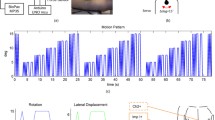Abstract
We have studied the effect of the electrode configuration on the measurement of body impedance and found that the electrode configuration greatly affects the impedance measurement using the four-electrode method. We studied the characteristics of the compound electrode and found that the compound electrode provides the four-electrode method in a compact form. A new method of measuring the skin impedance using simple electrodes at low frequencies was developed. At high frequencies where the effect of internal tissue impedance is not negligible, we used the compensation method using compound electrodes, because they measure the voltage right under the skin. At 50 kHz, we measured the real part of the skin impedance of less than 80 Ω on the thorax. We propose a simple instrument which can measure accurate skin impedance at various frequencies.
Similar content being viewed by others
References
Cheng, K. S., Simske, S. J., Isaacson, D., Newell, J. C. andGisser, D. G. (1990) Errors due to measuring voltage on current-carrying electrodes in electric current computed tom-ography.IEEE Trans.,BME-37, 60–65.
Hua, P., Woo, E. J., Tompkins, W. J. andWebster, J. G. (1989) An electrical impedance tomograph using compound electrodes. Proc. Ann. Int. Conf. IEEE Eng. in Med. & Biol. Soc., Washington DC, 5th–8th Nov., 472–473.
Kaczmarek, K. A., Webster, J. G., Bach-y-Rita, P. andTompkins, W. J. (1991) Electrotactile and vibrotactile displays for sensory substitution systems.IEEE Trans.,BME-38, 1–16.
Newell, J. C., Isaacson, D. andGisser, D. G. (1990) Rapid assessment of electrode characteristics for impedance imaging.,BME-37, 735–738.
Rosell, J., Colominas, J., Riu, P., Pallas, R. andWebster, J. G. (1988) Skin impedance from 1 Hz to 1 MHz.,BME-35, 649–651.
Webster, J. G. (1992) Measurement of flow and volume of blood. InMedical instrumentation: application and design, 2nd edn.Webster, J. G. (Ed.) Houghton Mifflin, Boston.
Yamamoto, T. andYamamoto, Y. (1976a) Electrical properties of the epidermal stratum corneum.Med. & Biol. Eng.,14, 151–158.
Yamamoto, T. andYamamoto, Y. (1976b) Dielectric constant and resistivity of epidermal stratum corneum.,14, 494–499.
Yamamoto, Y., Yamamoto, T. andOzawa, T. (1986) Characteristics of skin admittance for dry electrodes and the measurement of skin moisturisation.Med. & Biol. Eng. & Comput.,24, 71–77.
Author information
Authors and Affiliations
Rights and permissions
About this article
Cite this article
Woo, E.J., Hua, P., Webster, J.G. et al. Skin impedance measurements using simple and compound electrodes. Med. Biol. Eng. Comput. 30, 97–102 (1992). https://doi.org/10.1007/BF02446200
Received:
Accepted:
Issue Date:
DOI: https://doi.org/10.1007/BF02446200




